Protein G Magnetic Beads for IP/CoIP/ChIP
Catalog number :IF2103
Protein G Magnetic Beads are an affinity matrix for the small-scale isolation of immunocomplexes from immunoprecipitations (IP assays, CoIP, or ChIP). Protein G is covalently coupled to a magnetic particle. Protein G exhibits high affinity for subclasses of IgG from many species (including human, mouse, rat, and goat) and can be used for immunoprecipitation assays with these antibodies. Beads can be separated from solution using our 6-Tube Magnetic Separation Rack or 12-Tube Magnetic Separation Rack which concentrates the beads to the side of the tube instead of the bottom. This eliminates centrifugation steps, minimizes sample loss, increases washing efficiency, and saves time. The 1mL size is enough material for 40 immunoprecipitations, respectively, when following our recommended protocol.
- Overview
- Tested applications
- Immunoprecipitation (IP),Co-Immunoprecipitation (Co-IP),Chromatin Immunoprecipitation (ChIP),Suitable for use at 25-40 µL beads slurry per IP reaction. Optimal amount should be determined by the end user.
- Product Picture
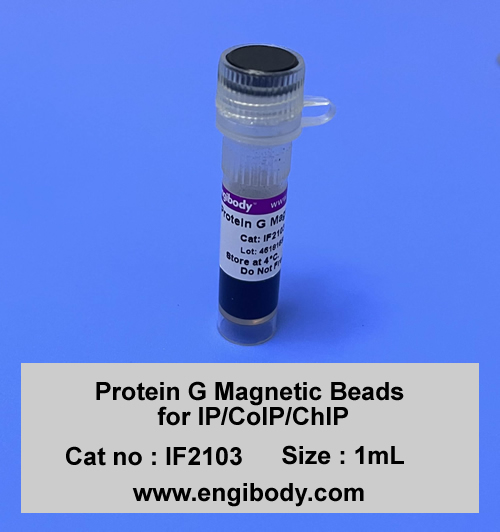
- Specificity
- Protein G Magnetic Beads is most suitable for IP/CoIP/ChIP of mouse IgG and goat IgG1, IgG2, IgG3 and IgG4.
- Properties
- Form
- Supplied in PBS (pH 7.4), and 0.02% sodium azide.
- Storage instruction
- Store at 4°C. This product is stable for 12 months. Do not freeze, dry or centrifuge beads. This may cause irreversible aggregation and decreased binding capacity.
- Structure Image
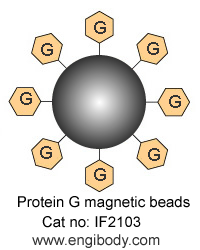
- Beads Diameter
- 1 µm
- Binding Capacity
- > 600 µg of antibody (mouse IgG) can be bound per ml of beads slurry.
- Beads Concentration
- 30 mg settled beads/ 1 mL beads slurry
- Applications
- Application Figure 1
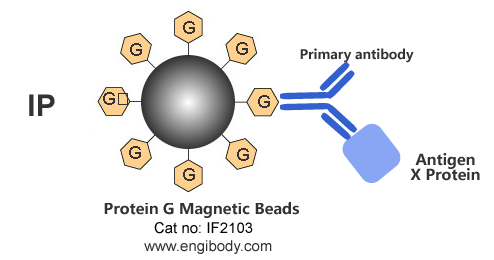
- Application Figure 2
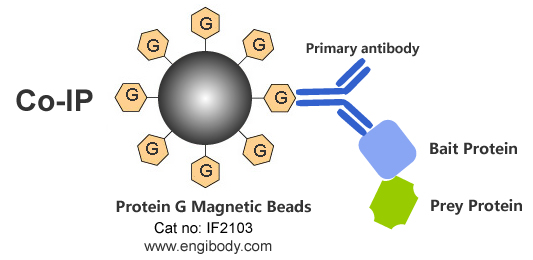
- Application Figure 3
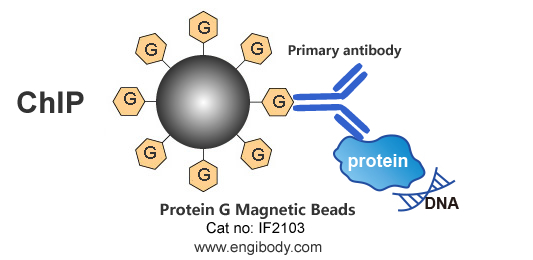
- Protocols
- Procedure for using Protein G Magnetic Beads in Magnetic IPA. Mammalian Cell LysisProtocol I: Lysis of Adherent Cell Cultures1. Carefully remove culture medium from cells.2. Wash the cells once with 1X PBS.3. Add ice-cold Lysis Buffer for IP (Cat: IF6601) to the cells. Incubate on ice for 10-20 minutes with periodic mixing.Note: Protease/Phosphatase Inhibitor Cocktail should be added to Lysis Buffer. Protease inhibitors are rapidly inactivated in aqueous solutions and should be added to solutions immediately before use.Table 1. Suggested volume of IP Lysis Buffer to use for different standard culture plates.Plate Size/Surface AreaVolume of Lysis Buffer for IP100 mm dish 500-1000 μL60 mm dish 250-500 μL4. Transfer the lysate to a microcentrifuge tube and centrifuge at ~ 13,000 × g for 10 minutes to pellet the cell debris.5. Transfer supernatant to a new tube for protein concentration determination and further analysis.IMPORTANT: The optimal lysate concentration will depend on the expression level of the protein of interest. A starting concentration between 250 μg/mL-1.0 mg/mL is recommended.Protocol II: Lysis of Cell Suspension Cultures1. Centrifuge the cell suspension at 1000 × g for 5 minutes to pellet the cells. Discard the supernatant.2. Wash cells once by suspending the cell pellet in PBS. Centrifuge at 1000 × g for 5 minutes to pellet cells.3. Add ice-cold Lysis Buffer for IP (Cat: IF6601) to the cell pellet. Use 500μL of Lysis Buffer for IP per 50 mg of wet cell pellet (i.e., 10:1 v/w). If using a large amount of cells, first add 10% of the final volume of Lysis Buffer for IP to the cell pellet and pipette the mixture up and down to mix. Add the remaining volume of Lysis Buffer for IP to the cell suspension.Note: Protease/Phosphatase Inhibitor Cocktail should be added to Lysis Buffer. Protease inhibitors are rapidly inactivated in aqueous solutions and should be added to solutions immediately before use.4. Incubate lysate on ice for 5 minutes with periodic mixing. Remove cell debris by centrifugation at ~ 13,000 × g for 10 minutes. Transfer supernatant to a new tube for protein concentration determination and further analysis.IMPORTANT: The optimal lysate concentration will depend on the expression level of the protein of interest. A starting concentration between 250 μg/mL-1.0 mg/mL is recommended.B. Pre-clear lysate using the Protein G Magnetic Beads (this step is optional, pre-clearing the lysate will reduce non-specific binding of proteins to the Magnetic beads. You can do this step if high background occurs in downstream assay.)1. Pre-clear the cell lysate by adding 20 µL of Protein G magnetic beads slurry per 1 mL of cell lysate and incubating at 4 °C for 10 minutes on a rotator.2. Remove the Protein G magnetic beads by 24-Tube Magnetic Separation Rack (Cat: IF9050). Transfer the supernatant (cell lysate) to a fresh centrifuge tube on ice.Note: In this step after magnetic separation the Protein G magnetic beads should be discarded, the supernatant should be saved for further IP.3. Determine the protein concentration of the cell lysate (e.g. if performing a Bradford assay one must dilute the cell lysate at least 1:10 before determining the protein concentration because of the interference of the detergents in the lysis buffer with the Coomassie-based reagent).C. IPNote:• Protein G magnetic beads (Cat: IF2103) should be resuspended well before used.• Perform all IP steps at 4°C unless otherwise indicated.• The amount of bait-prey complex required and incubation time depends upon the system used and the affinity of the antibody, antigen interactions and must be optimized for each system.• It may be necessary to optimize the binding time for each application1. Transfer 1 mL of the above cell lysate, or approximately 1000 µg total cellular protein, to a 1.5 mL microcentrifuge tube. Add the recommended volume of the primary antibody (optimal antibody concentration should be determined by antibody datasheet) and Normal IgG(2.5µL), then incubate for 2 hours or overnight at 4 °C on a rotator.Note: Normal Rabbit IgG (Cat: AT1597) is a nonspecific antibody, it can be used as Isotype Control of primary antibody from rabbit. Normal Mouse IgG (Cat: AT1596) is also a nonspecific antibody, it can be used as Isotype Control of primary antibody from mouse.2. Add 25 µL-40 µL of resuspended volume of protein G magnetic beads slurry to capture the antigen-antibody immunocomplex. Incubate at 4 °C on a rocker platform or rotating device for 1-2 hours.3. Collect immunoprecipitation complex by 24-Tube Magnetic Separation Rack (Cat: IF9050) at 4°C. Carefully aspirate and discard supernatant.4. Wash the complex 2-3 times with 0.5 mL Wash buffer for IP (Cat: IF9210), each washing lasts for 5-10 minutes. Resuspend the beads complex pellet by pipette tip suction before each wash.Tip: Increase the number of washes to 5-6 times if high background occurs.D. Elution and obtaining of the antigen proteinTwo methods are recommended according to protein characteristics or further usage:Option A: Elution with Elution Buffer (Cat: IF9213). This is a fast and efficient elution method. Equilibration of the eluted proteins with Neutralizing Buffer (Cat: IF9216) may help preserve its activity.Option B: Boil with Sample Loading Buffer (Cat: IF6740), Centrifuge and get the supernatants for gel electrophoresis and western blotting.Option A: Elution with Elution Buffer (Non-denaturing elution)The procedure should be performed at room temperature.Note: Do not leave the beads in this buffer more than 20 minutes.1. Add 100 µL of Elution Buffer to each sample and control beads complex, and resuspend the beads complex pellet by pipette tip suction.2. Incubate the samples and controls for 5 minutes at room temperature.3. Magnetic separation by 24-Tube Magnetic Separation Rack.4. Transfer the supernatants to fresh test tubes. Be careful not to transfer any beads.5. In order to equilibrate the eluant, immediately add 10 µL of Neutralizing Buffer to each sample. Then use a pH meter to make sure the pH is 7-8.6. For immediate use, store the eluted proteins at 2–8 °C. Store at –20 °C for long term storage.Option B: Boil with Sample Loading Buffer working solution, Centrifuge and get the supernatants for gel electrophoresis and western blotting. (Denaturing elution)The procedure should be performed at room temperature. Sample Loading Buffer should be at room temperature before use.1. Prepare Sample Loading Buffer working solution, adding 6 µL 5×Sample Loading Buffer into 24 µL Lysis Buffer for IP.2. Add 30 µL of Sample Loading Buffer working solution to each sample and control beads complex, briefly vortex to mix, and briefly microcentrifuge to pellet the sample3. Boil the samples and controls for 10 minutes to dissociate the immunocomplexes from the beads.4. Pellet beads using magnetic separation rack. The supernatant is the sample. Transfer the supernatants to fresh test tubes. The samples and controls are ready for loading on SDS-PAGE and immunoblotting.
Related Products
| Catalog number | IF0002 |
| Catalog number | IF2102 |
Reviews
loading...